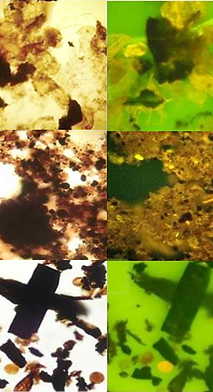
OUR SERVICES




Vitrinite reflectance
Vitrinite is the term used by organic petrologists when referring to preserved woody tissues (primary xylem). It is highly sensitive and alters in a linear response to increased thermal stress and residence time. This response is why vitrinite is used as the prime proxy for temperature. Vitrinite reflectance measurement remains the standard technique for accurate, fast and cost effective means of determining the thermal maturity of source rocks. In addition to helping define maturity thresholds for indications of hydrocarbon generation, vitrinite reflectance data are useful in determining fluid flow architecture in basin modeling.
While whole rock samples have the advantage of presenting vitrinite particles in-situ, we also perform vitrinite reflectance on kerogen isolate samples when requested by the client.
Vitrinite reflectance data is reported in tables, depth plots, and histograms. We also provide clients with photomicrographs of typical views of organic matter assemblages in incident white light and blue light. Vitrinite reflectance analysis is performed in incident white light (546 nm) under oil immersion (ne 1.517@ 23ºC) in non-polarized light.
In samples devoid of vitrinite, other particles can be measured. These include chitinozoans, graptolites and solid bitumens. Various calibrations are made to convert these to vitrinite reflectance equivalents. In cases where organic matter is not present, we can recommend apatite fission tracking or conodont alteration indexing (CAI).
Visual kerogen type
Visual Kerogen Typing is a quick and fairly cost effective way to give an optical assessment of the percentages of various organic matter particles present in an assemblage. This data can be used to interpret depositional environments and source inputs and the hydrocarbon potential of a kerogen and whether it is prone to generate oil or gas.
Kerogen is defined as insoluble, non-extractable organic matter found in sedimentary rocks. Kerogen is excised from mineral matrices using acid digestion. The purified matter is strewn onto a clear glass microscope slide for analysis.
Kerogen Typing is based on four major organic matter assemblages.
-
Type I is comprised of amorphous and/or algal matter and is oil-prone.
-
Type II is a mixture of amorphous and structured herbaceous/woody debris and is both oil and gas-prone.
-
Type III is comprised of structured woody and herbaceous matter that is mostly gas-prone.
-
Type IV is comprised of inert, charcoal-like, overmature organic matter that essentially has no remaining potential for hydrocarbon generation.
Kerogen Typing has the advantage over chemical pyrolysis approaches in that the analyst can identify individual components of a kerogen assemblage. This detailed information is lost in pyrolysis, where the whole kerogen is analyzed in bulk form. The advantage of pyrolysis data is that it is slightly more quantitative and data can be superimposed on van Krevelen type plots.
Visual kerogen analysis also provides thermal maturation information from spore thermal alteration index/spore color index (TAI/SCI) and when used in conjunction with blue light excitation and spore fluorescence color provides powerful constraints on thermal maturity data and hydrogen richness.
Visual kerogen analysis is performed using a Zeiss Standard 14 microscope fitted for blue light excitation (450-490, FT 510, LP 520) and transmitted light (blue, daylight filter). Thermal alteration Index or spore colour index (TAI/SCI), Spore Fluorescence Color (SFC) and percent distributions are made using a Zeiss Ph 2 40x/0.75 Neofluar lens.
Spore TAI/SCI, LFC
Spore coloration index (SCI) is highly sensitive to thermal change. With increasing maturity there is progressive darkening in color and opacity of spores. It uses a 1-10 scale. Thermal alteration index (TAI) is similar to SCI, but all liptinite is examined for coloration changes and uses a different scale. While these techniques are very sensitive, problems can arise in calibration, as many different standard classification scales exist.
When irradiated with blue and UV light liptinite, at certain levels of thermal maturation, exhibits fluorescence coloration (LFC). This coloration is also accompanied by varying levels of intensity. The intensity of fluorescence is an indicator of hydrogen richness. The fluorescence coloration is another independent proxy for thermal maturation. TAI/SCI and LFC provide highly constrained set of thermal maturity and hydrogen-richness indications when assessed together.
Geochemical
In addition to optical petrology we offer typical screening methods that help focus attention and budgets to target horizons. These include TOC analysis and Rock Eval pyrolysis.
More detailed analysis that can indicate the type of depositional environment such as biomarker analysis, 2D-GC, isotope studies and radiocarbon dating on inidviual organic molecules can be arranged through our partners.